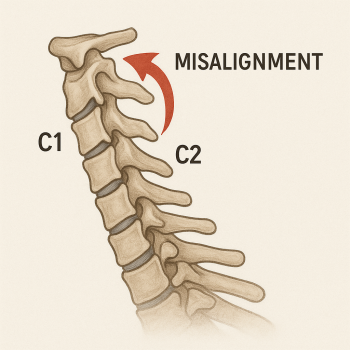
Trigeminal neuralgia (TN) may sometimes present secondary to an intra-cranial cause. Arnold Chiari Malformation (ACM) is downward herniation of the cerebellar tonsils through the foramen magnum that may be a cause of TN like pain in very rare cases.
Aims
The aim of this brief report is to suggest the proper management of uncommon secondary trigeminal neuralgia related to a rare Arnold Chiari type I malformation.
Methods
A male patient presented electric shock like stabbing pain on the right side of the face for more than ten years. The symptoms were typical of trigeminal neuralgia except that there was loss of corneal reflex on the right side and the patient also complained of gait & sleep disturbances. Complex and multilevel diagnosis was made.
Results
A multiplanar imaging through brain acquiring T1/T2W1 revealed ACM Type I Malformation with caudal displacement of cerebellar tonsils through foramen magnum.
Conclusion
Dental surgeons and oral and Maxillofacial Surgeons should exclude intra-cranial causes by Magnetic Resonance Imaging (MRI) in patients of TN presenting with loss of corneal reflex, gait and sleep disturbances due to night time pain episodes.
The severe trigeminal neuralgia could be related to ACM also thanks to the unusual finding of the loss of corneal reflex. What are the implications for research, policy, or practice? This case highlighted how a correct diagnosis must first exclude the severe intra-cranial pathology in case of TN.
Background
Trigeminal neuralgia (TN) is a chronic condition characterized by pain presenting in brief episodes, in one or more distributions of the trigeminal nerve. Episodes of pain secondary to TN are triggered by specific or not specific stimuli, such as chewing, shaving, or touching the face.
A common cause of TN is compression of the trigeminal nerve root entry zone by an artery or vein, many cases of TN are idiopathic. Trigeminal neuralgia (TN) a sudden, usually unilateral, severe, brief, stabbing, recurrent pain in the distribution of one or more branches of the fifth cranial nerve is one of the most painful conditions of the face and has profound impact on quality of life as this prevents the patient from speaking, eating, drinking, touching or washing of the face and brushing teeth.
TN patients often initially presents to dental surgeons who subsequently refer them to Oral & Maxillofacial Surgeons. Patients with TN are at times misdiagnosed and undergo misguided, unnecessary procedures and ineffective treatments.
Some clinicians consider the diagnosis of TN to be purely history and clinical examination based without the need for any further investigation.In majority of cases TN may be primary (idiopathic) but rarely may arise secondary to an intracranial cause.
Typically, TN is diagnosed by the patient’s clinical history, supported by a negative neurologic exam, and after a positive response to a trial of carbamazepine. NMR studies are often useful, especially when the diagnosis is uncertain or neurologic disorders are present.
Many conditions are triggered by the compression of the Trigeminal nerve, even if the compression is within a few millimeters before to entry into the pons. Neuroimaging may help in differentiating between primary and secondary TN by identify an intracranial cause in up to 15 per cent of patients and thus help correct diagnosis and management.
TN may rarely be associated with Arnold Chiari 1 malformation (ACM). ACM is a group of complex brain abnormalities traditionally defined as downward herniation of the cerebellar tonsils through the foramen magnum.
Diagnosis of ACM with MRI evaluation of posterior cranial fossa is confirmed if the cerebral tips have exceeded 5mm below the foramen magnum. It occurs in about 0.4:1000 live births and has formed 3 per cent of all abortions.
Case details
A 65-years-old male presented electric shock like stabbing pain on the right side of the face for more than ten years. He was unable to eat, drink, speak or sleep properly because of the severity and multiple episodes of pain during day and even at night during sleep.
He was taking carbamazepine 200mg and gabapentin 300mg twice daily without much relief in pain. On clinical examination there was loss of corneal reflex on the right side and the patient also complained of gait disturbances.
On intra oral examination he had lost most of his teeth because of his inability to maintain proper oral hygiene due to the triggering of pain while brushing. He lost some of his teeth due to the TN pain mimicking as a toothache during the early stages of his disease as shown in his panoramic radiograph.
Based on history and clinical examination, secondary TN was suspected, and an MRI brain scan was an advised to identify probable intra cranial cause for the pain. A multiplanar imaging through brain acquiring T1/T2W1 revealed caudal displacement of cerebellar tonsils through foramen magnum. There was compression of cervico-medullary junction with syrinx in the cervical cord suggesting Arnold Chiari malformation type I. The patient was subsequently referred to the neurosurgery department for the decompression (occipital craniotomy and laminectomy).
Discussion
Chiari malformations (CM) named after Hans Chiari, an Austrian pathologist, who first identified this pathology 1891. After that Ulius Arnold further elaborated on malformation it became now to be known as Arnold-Chiari malformation (ACM). ACM is classified into four types.
Specifically, type 1 is characterized by herniation of cerebellar tonsils alone, radiologically as simple tonsillar herniation 5mm or greater, below the foramen magnum. Presentation of TN secondary to ACM is extremely rare as a very small number of such cases have been reported in scientific literature. In this specific clinical report, we first describe a TN secondary to ACM in whole country of Pakistan.
The pathophysiology of TN secondary to ACM is hypothesized to be due to a variety of problems that may include vascular compression at the nerve root entry zone (NREZ) of fifth cranial nerve, demyelination of the trigeminal NREZ, micro-ischemic changes and direct brainstem compression.
In ACM spinal tract of the trigeminal nucleus is more susceptible as it is located dorsally and is poorly myelinated. A variety of treatment options are available for TN secondary to ACM that may include microvascular decompression (MVD), retro-sigmoid craniotomy, endoscopic third ventriculostomy and ventricular shunt procedures. Craniocervical decompression hasbeen reported with 73 per cent resolution of pain symptoms.
It could be interesting to approach future therapies by using of mesenchymal stem cells, given their paracrine immunoregulatory effects.19 Several risk factors should be also avoided in TN, as some factors could be involved in the processes of cytopathic hypoxia and of cellular oxidative stress.
Finally, the diagnosis must even consider, and exclude, oncological issues, and syndromic conditions especially those related to oral and maxillofacial regions, or micro- and macro-trauma, eventually treated with traditional or innovative autologous scaffolds.
Conclusion
Chiari I malformation usually presents with headache, numbness, weakness and gait abnormalities. This case report is an addition to the very few reported cases of TN secondary to ACM.
Dental surgeons and oral & Maxillofacial Surgeons should consider this diagnosis in patients of TN presenting with loss of corneal reflex, gait and sleep disturbances due to night time pain episodes; theand unsuitable treatment interventions.
This report supports early surgical intervention for symptomatic patients to achieve long-term pathophysiology of TN in these cases may be due to neurovascular conflict. MRI in all patients presenting with TN is mandatory, which may provide valuable etiological information, prevent the progression of the disease, and avoid erroneous diagnosis surgical benefit.
The Patient lost some of his teeth due to the TN pain mimicking as a toothache during the early stages of his disease as shown in his panoramic radiograph. Most TN patients lose some or all of their teeth before getting diagnosed.
Figure- MRI Brain showing caudal displacement of cerebellar tonsils through foramen magnum Dr. Mike’s point, “This can bemanaged with Burcon cervical specific chiropractic care. Why resort to drugs and surgery when specific adjustments work just as well?
This patient got rid of her Meniere’s symptoms for five months with surgery. Then they came back until I adjusted her with the approval of her MD. That adjustment also held for five months,” Dr. Michael T. Burcon, B.Ph, D.C.




Leave a comment